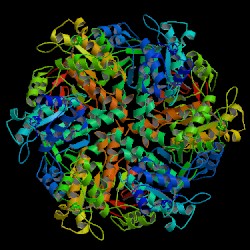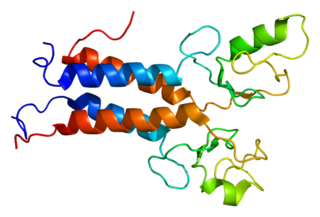BRCA1-A complex subunit BRE is a protein that in humans is encoded by the BRE gene. [5] [6] [7]
BRCA1-A complex subunit BRE is a protein that in humans is encoded by the BRE gene. [5] [6] [7]
BRE, the protein product of the BRE (gene), is a core component of the deubiquitin complex BRCA1-A. [8] Other core components of the BRCA1-A complex are the BRCC36 protein (BRCC3 gene), MERIT40 protein (BABAM1 gene), and RAP80 protein (UIMC1 gene). [8]
BRCA1, as distinct from BRCA1-A, is employed in the repair of chromosomal damage with an important role in the error-free homologous recombinational (HR) repair of DNA double-strand breaks. Sequestration of BRCA1 away from the DNA damage site suppresses homologous recombination and redirects the cell in the direction of repair by the process of non-homologous end joining (NHEJ). [8] The role of BRCA1-A appears to be to bind BRCA1 with high affinity and withdraw it away from the site of DNA damage to the periphery where it remains sequestered, thus promoting NHEJ in preference to HR.
BRE (gene) has been shown to interact with:

Breast cancer type 1 susceptibility protein is a protein that in humans is encoded by the BRCA1 gene. Orthologs are common in other vertebrate species, whereas invertebrate genomes may encode a more distantly related gene. BRCA1 is a human tumor suppressor gene and is responsible for repairing DNA.

DNA repair protein RAD51 homolog 1 is a protein encoded by the gene RAD51. The enzyme encoded by this gene is a member of the RAD51 protein family which assists in repair of DNA double strand breaks. RAD51 family members are homologous to the bacterial RecA, Archaeal RadA and yeast Rad51. The protein is highly conserved in most eukaryotes, from yeast to humans.

Ku80 is a protein that, in humans, is encoded by the XRCC5 gene. Together, Ku70 and Ku80 make up the Ku heterodimer, which binds to DNA double-strand break ends and is required for the non-homologous end joining (NHEJ) pathway of DNA repair. It is also required for V(D)J recombination, which utilizes the NHEJ pathway to promote antigen diversity in the mammalian immune system.

Poly [ADP-ribose] polymerase 1 (PARP-1) also known as NAD+ ADP-ribosyltransferase 1 or poly[ADP-ribose] synthase 1 is an enzyme that in humans is encoded by the PARP1 gene. It is the most abundant of the PARP family of enzymes, accounting for 90% of the NAD+ used by the family. PARP1 is mostly present in cell nucleus, but cytosolic fraction of this protein was also reported.

Double-strand break repair protein MRE11 is an enzyme that in humans is encoded by the MRE11 gene. The gene has been designated MRE11A to distinguish it from the pseudogene MRE11B that is nowadays named MRE11P1.

BRCA1-associated RING domain protein 1 is a protein that in humans is encoded by the BARD1 gene. The human BARD1 protein is 777 amino acids long and contains a RING finger domain, four ankyrin repeats, and two tandem BRCT domains.

DNA repair protein XRCC3 is a protein that in humans is encoded by the XRCC3 gene.

Flap endonuclease 1 is an enzyme that in humans is encoded by the FEN1 gene.

Fanconi anemia group D2 protein is a protein that in humans is encoded by the FANCD2 gene. The Fanconi anemia complementation group (FANC) currently includes FANCA, FANCB, FANCC, FANCD1, FANCD2, FANCE, FANCF, FANCG, FANCI, FANCJ, FANCL, FANCM, FANCN and FANCO.

Fanconi anemia group G protein is a protein that in humans is encoded by the FANCG gene.

RAD52 homolog , also known as RAD52, is a protein which in humans is encoded by the RAD52 gene.

Ubiquitin-conjugating enzyme E2 D1 is a protein that in humans is encoded by the UBE2D1 gene.

DNA repair protein RAD51 homolog 4 is a protein that in humans is encoded by the RAD51L3 gene.

DNA repair protein XRCC2 is a protein that in humans is encoded by the XRCC2 gene.

Fanconi anemia group J protein is a protein that in humans is encoded by the BRCA1-interacting protein 1 (BRIP1) gene.

E3 ubiquitin-protein ligase FANCL is an enzyme that in humans is encoded by the FANCL gene.

BRCA1-A complex subunit RAP80 is a protein that in humans is encoded by the UIMC1 gene.

Lys-63-specific deubiquitinase BRCC36 is an enzyme that in humans is encoded by the BRCC3 gene.

Partner and localizer of BRCA2, also known as PALB2 or FANCN, is a protein which in humans is encoded by the PALB2 gene.

BRCA1-A complex subunit MERIT40 is a protein that in humans is encoded by the BABAM1 gene.